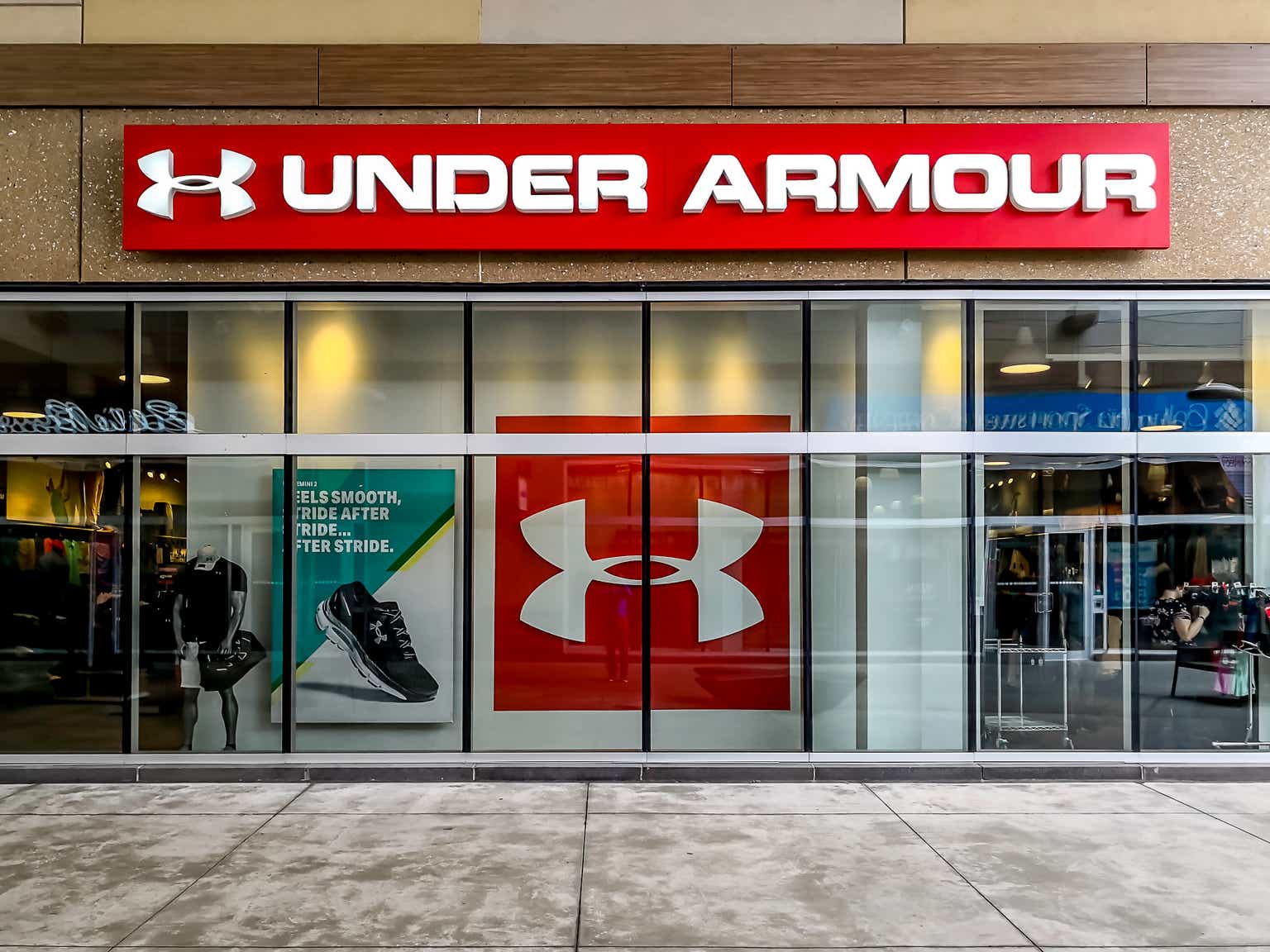Summary
Under Armour (NYSE:UA, NYSE:UAA) has experienced huge litigation expenses over the past year due to a class action filed against them. The write downs have forced an otherwise profitable company into the doldrums of negativity. But with the return of founder Kevin Plank as CEO, Under Armour is now beginning to turn the corner. The litigation is in the rear view mirror, paving the way for comeback-style growth that should outperform in the coming years ahead. There are mixed macro signals, however, that warrant a slow, piecewise investment in UA shares.
What is weighing down UA shares?
It has become clear over the past couple of years – really, since UA initiated its transition period in March 2022 – that there are some skeletons in the closet. Over fiscal 2023 and 2024, sales dropped over 3%, at a time when the consumer has been flush with cash, and competitors like Nike (NKE), Lululemon (LULU), and adidas (OTCQX:ADDYY) managed flat-to-double digit gains (Lulu is the standout). Why has UA slipped into the market periphery, wholly ignored by investors? In part, there was less attention paid to details regarding productivity, and too much effort put into expanding the product line. One way to understand this is through conference calls with management. In doing so, we can glean some directional details of CEOs Plank and (formerly) Linnartz with respect to the vision of Under Armour. What follows are snippets from UA conference calls going back to 2023:
Q2 2023 – Plank: “…recognizing that in the product world of good, better, and best, we allowed the pendulum to swing too far creating an overemphasis on good level products.”
Q4 2023 – Plank: “In the product spectrum of good, better and best, Under Armour has built a $6 billion brand with a lot of good products, a fair amount of better and an opportunity with consumers for much greater representation of best level products.”
It is clear that management has been off the mark with products, and so the undertones of Plank’s strategy include reintroducing the “Protect this House” motif that brought success to the company years ago. This plan extended into Stephanie Linnartz’s CEO stint in late 2023-early 2024. She embraced “Protect This House 3”, with a focus on gaining market share with women and young athletes:
Q1 2024 – Linnartz on three phases of her strategy: ”First is driving global brand heat with an emphasis on the U.S.; second is delivering elevated design and products with a focus on footwear, sports sale and women; and third is driving U.S. sales while harnessing momentum in our international business. […] An essential theme underlying support of these brand heat moments is the importance of social media an always-on digital presence to connect with young athletes more deeply.”
Q2 2024 – Linnartz: “Therein lies the challenge, balancing P&O productivity and profitability, which as we’ve demonstrated, remains a priority for us to deliver to shareholders in the near-term. In this respect, we are continuing to dig into our product and marketing cost structures to determine how to best prioritize investments to the areas of highest return and deprioritize areas that may not be as productive for the brand.”
Q3 2024 – Linnartz: “As detailed previously, inconsistency has permeated our U.S. business over the past years. And how we go to market across consumers, customers and geographies, how our product is created and delivered with a consistent design language, channel segmentation, and how we show up in our own physical and digital businesses.”
Given the conflicting messaging between “brand heat” and balancing productivity and profitability, the strategy execution wasn’t perfect. In March 2024, Ms. Linnartz made the choice to step down from her role as CEO in rather abrupt fashion, leaving the door for Plank to reassume the role:
Q4 2024 – Plank: “A lack of continuity increased complexity of challenge to our execution. With several CEOs and Heads of Products Marketing in North America over the past half a decade, ongoing turnover of critical leadership has been central to our inability to stay agile and decisive.”
Quote mining isn’t the goal here, but rather informative causation. One can see in relatively short order that there has been a lack of direction at the top of the management chain – the C-suite office has been a revolving door for years. Perhaps with Plank’s assumption of control – he already has a strong ownership position that won’t change – there should be some increased continuity for the next 3-5 years. Moreover, if you believe the CEO’s commitment to product excellence, we might see some of the magic that made Under Armour burst onto the scene decades ago. Their products were fresh, innovative, and durable (personal anecdote: I still have two Under Armour “cold gear” base layer mocks some 15 years after purchasing them). One might argue that their products were too good…but over the long term, brand quality matters over product quantity.
What lies ahead for Under Armour? The opportunity for growth is there, especially in footwear. According to Mordor Intelligence, the market is expected to grow at 6.86% annually over the next five years, and here we have Under Armour reporting a 4.9% drop in footwear revenue over fiscal 2024. That is part of the big disconnect plaguing UA over these past few years, and the gap that management must close going forward. Consider for a moment that Nike drew $33 billion in footwear revenues last year (65% of total revenues, pg. 34, 2024 10-K), while Under Armour generated $1.3 billion in sales, roughly 25% of total revenues (pg. 31, 2024 10-K). The contrast is staggering. Look for UA to chip into market share over the coming quarters. If there’s even some meager percentage growth, you’ll know the company is on the right track.
Litigation is in the Past
Note 10 on the most recent 10-Q shows that one of the primary barriers to investment will soon come to conclusion. A Class Action was filed beginning in 2017 (consolidated into the “Third Amended Complaint”, or TAC), alleging that Under Armour and Mr. Plank “concealed purportedly declining consumer demand […] between the third quarter of 2015 and the fourth quarter of 2016 […]”, and going so far as to shift sales between quarterly reports to present the appearance of streamlined revenues. There is no doubt that these allegations were (and remain) serious; however, the complaint was settled in June 2024 for $434 million. In addition, the roles of Chair and CEO – which Mr. Plank sat in simultaneously in 2019 – must be separated for three years. One could consider the separation of power a good thing, and in the best interest of the company as well as its public shareholders.
There is additional litigation that remains ongoing – the Consolidated Kenney Derivative Litigation – in which the Maryland state court has issued a stay pending the outcome of the TAC mentioned above. There is no way to determine the extent of the Kenney Litigation or what it will cost the company, but it likely won’t be as large as the TAC, which is one of the largest class action recoveries we have ever seen.
Per the most recent press release, Under Armour’s SG&A expense was a whopping $837 million dollars, $200 million more than the previous quarter. This is no doubt due to the litigation expense; combine that with $300 million less in 2025 Q1 revenues, and it makes for a pretty ugly quarter on first glance. But reading through the tea leaves, one would expect the litigation sinking fund to be a one-off. Combine that with inventories dropping 15%, and you’ve got the underpinnings of a turnaround in profitability.
Macro Risks
We see that there is both opportunity for Under Armour to reclaim its standing as a top footwear & apparel player, and that the major litigation is in the rear view mirror. However, keep in mind the risk of UA is getting hit with macro cross-currents that don’t bode well for consumers. Inflation has hit its highest rate in 50 plus years, and we don’t yet know the extent of retail trade-downs or changes in consumer preferences. While the Michigan Consumer Sentiment Index tipped up in August, personal savings rates are below 3% for the first time since 2007, and consumer credit is at an all-time high. Similarly, the Bureau of Labor Statistics made the largest downward jobs revision in 15 years.
What these macro data points tell us is that the American consumer is the last bastion of an inflated economy. Moreover, we just don’t know if the consumer will continue to buy athletic apparel and footwear, trade down to more affordable brands, or simply be more frugal over the medium term. That is the great challenge Under Armour faces, along with major players like Nike, Adidas, Lululemon, and others. To a certain extent Under Armour must win back the consumer, and provide the necessary improvements to the product line in order to gain market share. The situation represents a double hurdle management must be keenly focused on.
Conclusion
The bottom line here is that Under Armour shares may have been beaten and battered enough to warrant an investment. It was once a thriving machine attempting to bring down the powerhouse that is Nike. The trend toward profitability and a certain return to glory may still be possible, but likely over the long-term. In the medium to short term, we don’t know how the consumer will respond to Under Armour’s reorganization. But more than that, the consumer may not have the credit to spend on new and improved products. That said, I’m walking a tight rope here: Under Armour presents an interesting investment, but if the inflated economy pops, the whole market will come with it, including UA shares. Under Armour still has brand power, and it’s a good investment for those who might be willing to wait, and take it slowly, should any market volatility pop up over the next six to twelve months.
Read the full article here









Leave a Reply